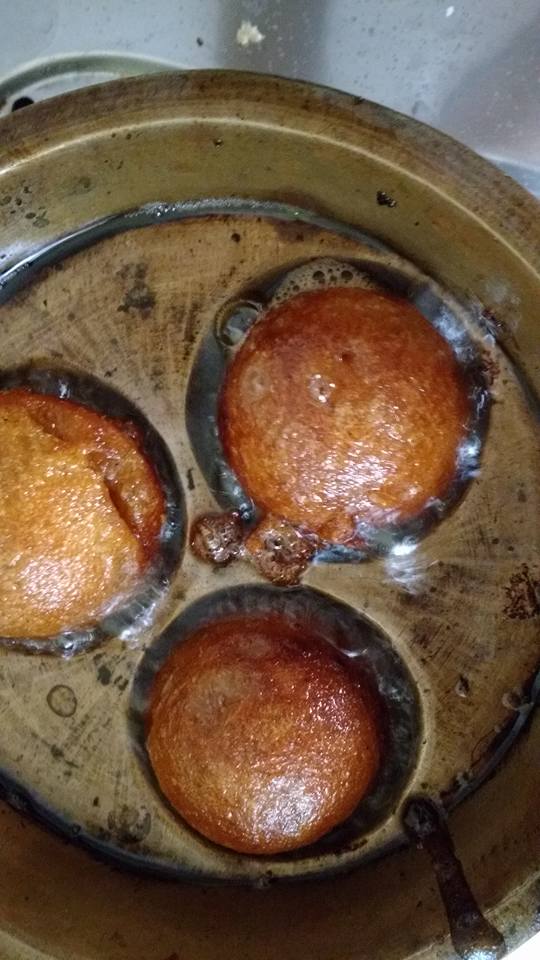Nei Appam
This traditional South Indian dessert is made for several festivals but is particularly associated with Krishna Jayanthi or Gokulashtami. Often considered rather difficult to pull off, I am, however, confident that this can be done successfully the first time following all the directions given. Gluten-free. Unlike some other sweets, its taste can vary from drab to wonderful based on the consistency and sweetness, in turn determined by the correct proportion and balance of ingredients.

Note on Ingredients and Utensils:
You will need an appam pan for this. Outside India, look for an ebelskiver pan – will work perfectly. The best pans are those that have deep and large depressions in them. Rather than make ten small appams, three or four larger ones will render better taste and flavour. Do NOT use non-stick pans – we will be deep frying the appams. A heavy iron or brass (as pictured) utensil would be best.
The ratio of the key ingredients, rice, jaggery and banana, is easy to remember: 1:1^:1. Use only raw white rice for this recipe. The jaggery used here is the variety called ‘paagu vellam’ in Tamil – this is the one that is NOT in beautiful, proportional geometric shapes at the store. It is usually in misshapen lumps with colour varying each time from coffee brown to mustard yellow to sandalwood to burnt orange.
While varieties of bananas abound, particularly in the tropics, for this recipe, use only the ubiquitous long and most common variety – as in ‘Chiquita’ bananas in the US, ‘Morris’ bananas or ‘pachchai pazham’ (green banana – this variety looks the Chiquita or Morris in shape but stays green even when ripe) in Tamil Nadu. This variety brings out the best banana flavour in the dessert.
I cannot recommend ghee strongly enough for this recipe – oil just will not give you the same taste. Fortunately, ghee is now, again, back in the running as good fat, so you might actually be doing yourself a favour taste AND health-wise.
I cup is 237-250ml and 1 teaspoon (tsp) is 5 ml.
Ingredients:
1 cup raw white rice, soaked in water for no more than 75 minutes.
1 heaped cup powdered jaggery (read note above)
1 long very overripe (as in banana bread) peeled banana
1 level tsp cardamom powder (skins to be discarded)
½ tsp dried ginger powder
¼ cup ghee
More ghee to fry
Method:
Add jaggery into a saucepan with ½ cup water and bring to a boil. Boil until a few drops put into room temperature water keeps the jaggery syrup distinct below – looking like grease stuck on the bottom. Cool slightly,
In the meantime, grind rice very fine in sufficient water in either a wet grinder or a very powerful blender – look for pancake batter consistency – it should NOT be too watery. The rice should be ground completely fine so it feels totally smooth and pasty. Now add banana. Grind until completely incorporated homogeneously with no lumps. Add jaggery syrup. Blend until well combined. Remove from grinder/blender, add cardamom powder, ginger powder and ¼ cup ghee. Mix until combined. The consistency of the finished batter should be like a Western cream soup, or paper dosa batter. Add extra water as needed to achieve this consistency. If the batter is too thick, you will get hard appams. The batter can be made a couple of days ahead of time and stored in the refrigerator. If making on the day of preparation, allow batter to sit for an hour or two at room temperature before frying.
Place appam pan on medium flame and fill each depression half way with ghee. Let it heat up until a drop of batter put in rises atop immediately. Now pour batter into each depression until just two millimetres below the brim. Remember the order in which you poured. In about three minutes, using a long implement like a metal knitting needle, a botkin or even a flathead screwdriver (cleaned, of course), carefully turn over the appams (in the same order in which you poured) and get it upside down so that the other surface can also fry fully. The appam is done when it is about coffee brown in colour – too black means you have burned it. Take it out using the same long implement, place in a colander for two minutes before storing in a glass or metal dish with a tight-fitting lid. This ensures the appams stay at the correct consistency for a whole day. It should be crisp on the outside and soft but non-sticky on the inside. Served fresh ideally, but it can be microwaved briefly if it has been sitting around awhile. Repeat, adding ghee, if needed, until all the batter is used up.
Do make it and share your feedback.
My favourite sweet 🙂
Love nei appam, especially prepared by you!!
நெய் அப்பம் makes me remember my amma, Palakkad roots and our own festivals and festivities of Kerala.
Krishnan
Used my mother-in-law’s appa kuzhi and made this for the first time – came out really well! Just like Lakshmi said, crisp on the outside and soft and fluffy on the inside. Enjoyed making it.
Kalyani
Perfect measurements. Tried for the 1st time with green banana (usually with poovan pazham) .Came out so beautifully and aromatic with ghee( like my mother says ‘pongi urundaya’). Texture was soft . Tried this for both Krishna Jayanthi and Vinayaka chaturuthi). Keeper recipe and will be one of the neivedyams for navarathri. Thank u so much